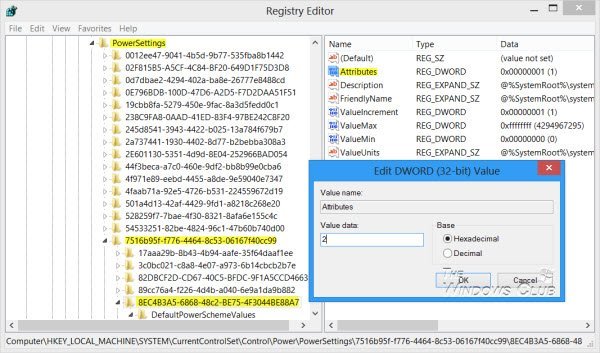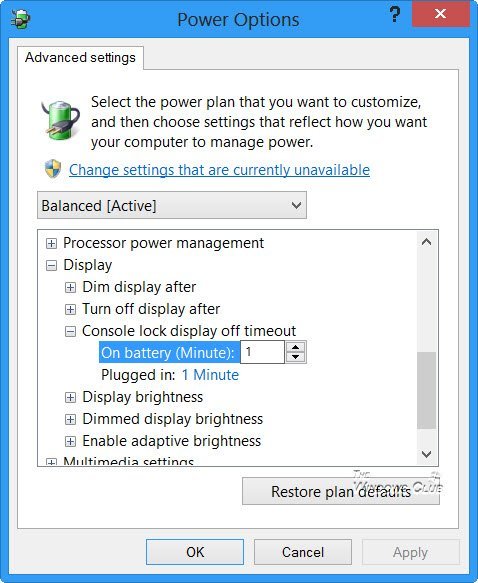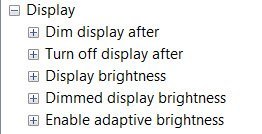Does your Windows computer turn off display after being locked for 1 minute? You can enable Console Lock Display Off Timeout in Windows Power Options and change Windows 11/10 Lock Screen Timeout Period, by following this tutorial.
Windows 11/10/8 users may have noticed that after your computer has been locked for 1 minute, the display is turned off. You may have via Control Panel options, set the PC never to sleep, never turn off the monitor, never turn off the hard disk and so on – but when the lock screen is visible, you may find that the monitor will turn off after 1 minute.
There is a reason for it! By default, when the console is locked, Windows waits for 60 seconds of inactivity before powering off the display. This setting is not configurable using the Windows user interface. If you wish to change this setting, you will have to follow these steps, which I came across.
Before you start, backup your registry or create a system restore point first.
Enable Console lock display off timeout

Open Registry Editor and navigate to the following key:
HKEY_LOCAL_MACHINE\SYSTEM\CurrentControlSet\Control\Power\PowerSettings\7516b95f-f776-4464-8c53-06167f40cc99\8EC4B3A5-6868-48c2-BE75-4F3044BE88A7
Now in the right pane, you will see Attributes. Double-click on it to change its DWORD value data from the default 1 to 2.
Read: How to change Screensaver timeout settings in Windows.
Change Windows Lock Screen Timeout Period

Having done this, now open Power Options > Advanced Power Settings via Control Panel. Expand the Display item.
You will now see an additional entry: Console lock display off timeout.
You would not have seen it earlier, but after editing the registry, you will get to see it.

Double-click on the values and change the settings from 1 Minute to what you wish. Setting it to 0 will never turn off the display.
There is another way to automatically Turn off the Monitor after locking Windows PC
You can also use the PowerCfg.exe utility to configure the display timeout – when the PC is in unlocked or locked, and when the system is plugged in and using AC power. To do this, open an administrative command prompt and run these commands one after the other to control the display timeout:
powercfg.exe /setacvalueindex SCHEME_CURRENT SUB_VIDEO VIDEOIDLE <time in seconds>
powercfg.exe /setacvalueindex SCHEME_CURRENT SUB_VIDEO VIDEOCONLOCK <time in seconds>
powercfg.exe /setactive SCHEME_CURRENT
Fill the time in seconds, in these commands. VIDEOIDLE timeout is used when the PC is unlocked, and VIDEOCONLOCK timeout is used when the PC is a locked screen.
To set the timeouts used when on DC (battery) power, use the /setdcvalueindex switch instead of /setacvalueindex.
You will now find that the monitor screen does not turn off after 1 minute of locking your Windows computer.
How do I stop Windows from locking after inactivity?
To stop Windows 11 from locking after inactivity, you need to open the Local Group Policy Editor and navigate to this path: Computer Configuration > Administrative Templates > Control Panel > Personalization. Then, double-click on the Do not display the lock screen setting and choose the Enabled option. Finally, click the OK button to save the change.
How do I make my laptop screen stay on longer in Windows?
You need to use the Windows Settings panel to make your laptop screen stay on longer in Windows 11/10. For that, open the Power & battery settings and choose the Screen and sleep option. From here, you can change the screen timeout settings on your computer.
This post can also be useful if Windows enables Sleep Mode instead of locking the screen.
this is fantastic advice! why would windows not think to make this a standard option, i.e. POWER CONTROL for WINDOWS ‘LOCKED SCREEN’
This was really frustrating, i run 3 amps through HDMI all air play , i like to lock the screen and control sound via remote, however when the computer locked it would turn display (HDMI) off – therefore killing the sound to the amp, whilst the other amp runs fine…
Thanks heaps the long way to turn on ‘Useful , functionality’ haha
Does the lock screen have a separate setting for turning off the hard drive also? My hard drive seems to turn off and on during the lock screen, even though power settings are set to never turn off the hard drive.
Wow! I am a novice and after struggling with several attempts to follow other advice from the net I followed yours and it worked first time. I am so grateful for your help which has enabled me to get rid of one (of the many!) annoying things in Windows 8
I too have been plagued by this problem (locking screen). Your advice seems to be the best & only solution out there. I only have one problem with it: I am not tech savy, unlike others on site. I need step by step directions to get to the above part of the registry editor. Also please instruct on how to change for all uses of this computer in my family (** most important) and if possible for individual user (if one user wants separate settings)
OK, I will edit and make the post, a little more detailed tomorrow. :)
Microsoft is arrogant and makes everything painful. OK, I feel better now.
thank you so much!
It doesnt work for me :-( when i change 1 to 2 it says”Cannot edit Attribute;Error writing the values new contents”
This doesn’t work with my Windows 8.1 , I only got “Turn off display after” and “Enable adaptive brightness”. The key under 7516b95f… looks all different here, only two entries.
Thanks
Genius.
Works but……..There seems to be a maximum value that works. I’d like it to be an hour, but when I set it for an hour the displays never turn off. If I set it for a smaller amount of time like 10 minutes it works fine.
Windows 10.0.16299
I was trying to get my screen to lock (requiring a password for re-entry, for security/privacy) as opposed to merely having the screen itself turn off. So I was intrigued by the hidden setting described in this post. But it doesn’t appear to do anything. Or maybe I’m misunderstanding its purpose. It sounds like the screen should lock, requiring your password to get back in. But the screen doesn’t, in fact, lock.
Anyway, on another Q&A page, there was a different answer: Go to the Screen Saver dialog (which is buried in Settings > Lock screen > Screen saver settings. Set the Wait time and check “On resume, display logon screen”. That locks the screen after the chosen time elapses!
So, what is “console lock display off timeout” supposed to do?